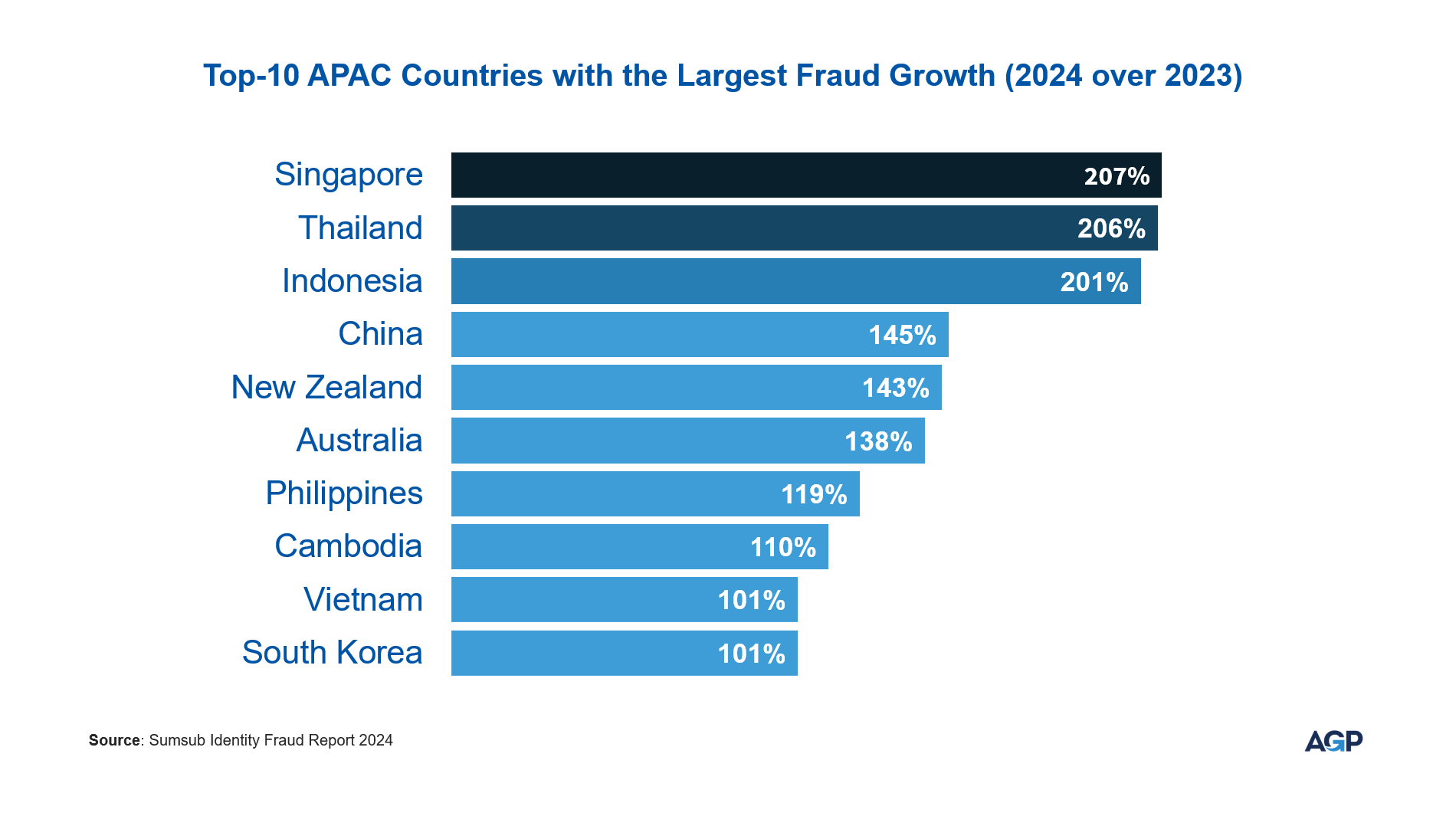Deepfakes in Asia: A Threat CEOs Cannot Ignore
The rise of deepfakes—AI-generated synthetic media—has become a defining challenge for businesses across Asia. The rapid proliferation of this technology introduces a host of risks, ranging from financial fraud to reputational crises. For CEOs and business leaders operating in Asia, understanding the nuances of this threat is a strategic imperative. This article delves into the current state of deepfakes in Asia to help businesses navigate this evolving landscape.
Proliferation Across Sectors
Deepfake incidents have increased by an astounding 1,530% from 2022 to 2023 across Asia-Pacific, with the Philippines leading this surge at 4,500% growth in cases during the same period. Vietnam, too, has experienced a significant increase, with fraud rates jumping by 25.3% in 2023 (source: Global Initiative Against Transnational Organized Crime). This exponential growth reflects not only the accessibility of deepfake tools but also their adoption by malicious actors across various domains.
Intensifying Risks
Industries such as banking, e-commerce, and telecommunications are particularly vulnerable to deepfake-related fraud. According to data from Sumsub’s Identity Fraud Report, fraud rates in these sectors have more than doubled over four years (2021–2024), reaching an alarming 2.6% in 2024. Furthermore, 8.9% of fraud in dating apps and 7.7% in online media platforms is directly attributed to deepfakes.
The 2024 fraud landscape across APAC is highly variable. Indonesia, for instance, stands out for its escalating fraud rate, reflecting increasingly advanced tactics exploiting the nation’s growing digital infrastructure. Even highly developed markets like Singapore and Thailand have experienced fraud surges exceeding 200%, illustrating that no country is immune to these evolving threats. Singapore’s move toward a cashless economy—marked by the widespread adoption of digital wallets, QR code payments, and contactless transactions—has opened new avenues for cybercrime. Fraudsters exploit weaknesses in these systems through tactics such as fake payment applications, fraudulent QR codes, and credential theft from digital wallets.

Key Technologies Driving the Threat
The democratization of AI tools has enabled even non-experts to create highly realistic deepfakes. Fraud-as-a-service platforms now offer pre-packaged solutions for creating deepfake content, significantly lowering the barriers to entry for cybercriminals (source: Sumsub Identity Fraud Report 2024).
Synthetic Identities: Fraudsters blend real and fabricated credentials to create synthetic personas, complicating identity verification systems. This technique is increasingly used in banking and e-commerce.
Camera Injection Attacks: These attacks exploit vulnerabilities in biometric verification systems, tricking devices into perceiving fake users as legitimate ones.
The Role of Large Language Models (LLMs): Deepfake creators increasingly leverage advanced AI models such as ChatGPT, MidJourney, and Gemini. These tools enable the seamless generation of synthetic voices, images, and videos indistinguishable from authentic content. For example, 66% of Indians report either falling victim to or knowing someone affected by deepfake scams within the last year (source: Indian Express, using research from McAfee India, 2024).
Sector-Specific Impacts
Financial Services in Asia
The banking sector in Asia faces heightened risks due to deepfakes, with significant data highlighting the regional impact:
- Singapore: 56% of businesses reported encountering deepfake-related fraud in their financial systems, leading to operational and reputational challenges (source: Regula Deepfake Trends 2024 Study).
- Malaysia: Financial services have faced a surge in identity fraud cases, with deepfakes used to manipulate KYC (Know Your Customer) processes, resulting in millions of dollars in losses (source: Fintech News Malaysia, November 2024).
- Indonesia: Synthetic identity fraud grew by 6.02%, one of the highest rates in Asia (source: Sumsub Identity Fraud Report 2024).
Corporate Reputation in Asia
Executives and public figures across Asia have become prime targets for deepfake attacks:
- Hong Kong: High-profile executives in the finance and technology sectors have reported incidents of deepfake videos used to spread false narratives or promote fraudulent investments.
- Singapore: A video of Senior Minister Lee Hsien Loong endorsing a fake investment product highlighted the risks deepfakes pose to corporate and government reputations (source: Frontier Enterprise 2024).
- Malaysia: Prominent business leaders have had their likenesses exploited in scams, leading to financial losses and reputational damage.
- Malaysia: Scammers used the likeness of singer Siti Nurhaliza to promote fraudulent schemes, demonstrating the weaponization of public trust (source: South China Morning Post, July 2024).
- Hong Kong: A case involving deepfake romance scams led to victims losing over USD 46 million, showcasing the negative financial implications for individuals and businesses alike (source: HKFP, January 2025).
Recommendations for CEOs and Business Leaders
Consider look into and invest in advanced security infrastructure:
- Deploy multimodal biometric verification systems to strengthen authentication processes.
- Integrate predictive analytics to identify and counteract emerging fraud patterns.
- Adopt real-time monitoring systems to detect anomalies and respond promptly to threats.
- Invest in blockchain technology to ensure the integrity of digital transactions and content.
- Use dynamic risk scoring to identify high-risk behaviors in real time.
- Adopt advanced biometrics to authenticate users with greater precision.
Foster organizational awareness: Train employees and educate consumers about deepfake risks, encouraging cautious online behavior such as verifying sources before sharing content.
Collaborate for a unified response: Work with industry peers and regulators to establish best practices and standardize anti-fraud measures. Participate in global forums to share insights and leverage international expertise in combating deepfake threats.
Key Takeaways
Deepfakes are not just a technological curiosity; they represent a significant shift in the way information is created and consumed. For business leaders in Asia, the implications are profound, spanning financial risks, reputational damage, and operational vulnerabilities.
By understanding the evolving landscape, investing in robust defenses, and fostering cross-sector collaboration, CEOs can mitigate the risks posed by deepfakes and position their organizations as leaders in digital trust and resilience. The stakes are high, but with the right strategies, the business community can rise to the challenge and safeguard the future of Asia’s digital economy.
Related Insights.











